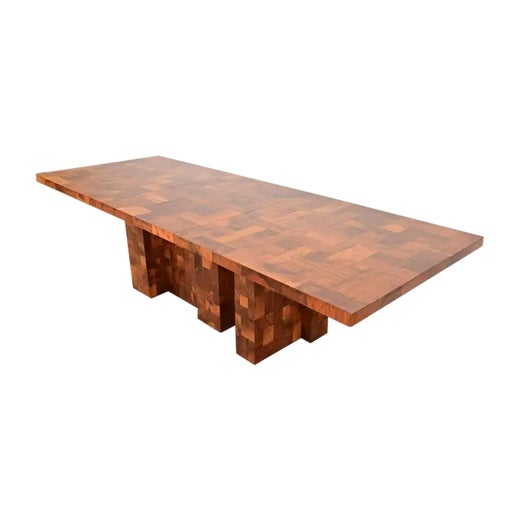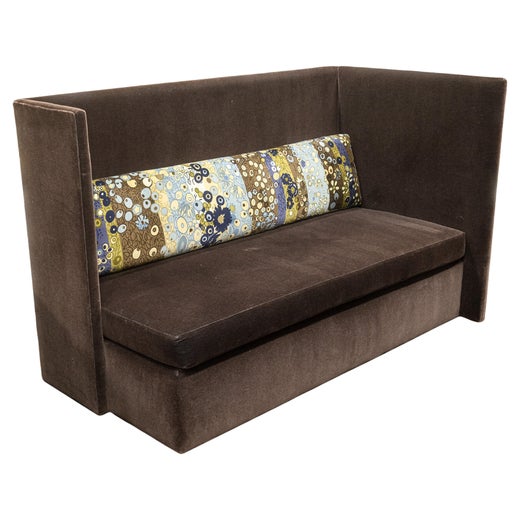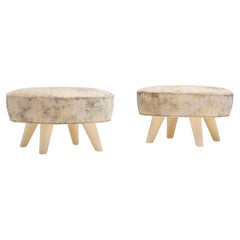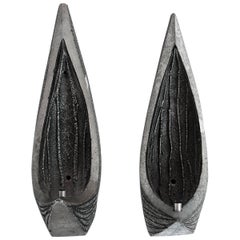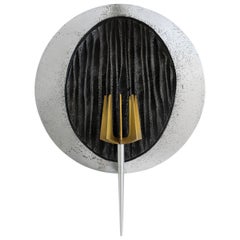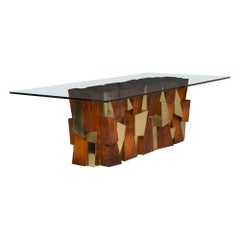Paul Evans Pair of Upholstered Stools
About the Item
- Creator:Paul Evans (Designer),Jack Lenor Larsen (Designer)
- Dimensions:Height: 17 in (43.18 cm)Width: 26 in (66.04 cm)Depth: 20 in (50.8 cm)Seat Height: 17 in (43.18 cm)
- Sold As:Set of 2
- Style:Mid-Century Modern (In the Style Of)
- Materials and Techniques:
- Place of Origin:
- Period:
- Date of Manufacture:circa 1975
- Condition:Wear consistent with age and use.
- Seller Location:Chicago, IL
- Reference Number:Seller: 0008951stDibs: LU84745598643
Paul Evans
A designer and sculptor, Paul Evans was a wild card of late 20th century modernism. A leading light of the American Studio Furniture movement, Evans’s sideboards, credenzas, coffee tables and other work manifests a singular aesthetic sense, as well as a seemingly contradictory appreciation for both folk art forms and for new materials and technologies.
Evans’s primary material was metal, not wood, which was favored by his fellow studio designers, and Bucks County, Pennsylvania, neighbors George Nakashima and Phillip Lloyd Powell. He trained in metallurgy and studied at the Cranbrook Academy of Art, the famed crucible of modern design and art in suburban Detroit. For a time early in his career, Evans also worked at Sturbridge Village, a historical “living museum” in Massachusetts, where he gave demonstrations as a costumed silversmith.
Evans’s earliest work unites these influences. The pieces that made his reputation are known as “sculpted-front” cabinets: wood cases faced with box-like high-relief patinated steel mounts laid out in a grid pattern. Each mount contains a metal emblem, or glyph, and the effect is that of a brawny quilt.
Evans’s later work falls into three distinct style groups. His sculpted-bronze pieces, begun in the mid-1960s, show Evans at his most expressive. He employed a technique in which resin is hand-shaped, and later sprayed with a metal coating, allowing for artistic nuance in the making of chairs, tables and case pieces. Later in the decade and into the 1970s, Evans produced his Argente series for celebrated manufacturer Directional (a brand known to vintage mid-century modern furniture collectors everywhere): consoles and other furniture forms that feature aluminum and pigment-infused metal surfaces welded into abstract organic forms and patterns.
Last, Evans's Cityscape design series — a milestone in the history of brutalist design — meshed perfectly with the sleek, “high tech” sensibility of the later ’70s. Evans constructed boxy forms and faced them with irregular mosaic patterns that mixed rectangular plaques of chromed steel, bronze or burlwood veneer. These, like all of Paul Evans’s designs, are both useful and eye-catching. But their appeal has another, more visceral quality: these pieces have clearly been touched by an artist’s hand.
Find a collection of authentic Paul Evans furniture today on 1stDibs.
Jack Lenor Larsen
Jack Lenor Larsen was a celebrated American mid-century modern textile designer born in Seattle. He fostered connections throughout the design and architecture industries beginning in 1950, and today, his influential eponymous design company is widely recognized for its muted hand-spun textured textiles. Larsen manufactured fabrics all over the world for more than six decades, using both traditional and modern weaving techniques.
Larsen initially studied in the architecture program at the University of Washington before he quickly realized he was instead interested in furniture design and interiors. He earned his MFA in 1949 from the Cranbrook Academy of Art — the go-to art school for design stars of the mid-20th century. The following year he moved and opened a studio in New York City where he launched his career.
For one of his first commissions, which was to design curtains for the Lever House — a New York City icon designed by Gordon Bunshaft and Natalie de Blois — Larsen created a linen and gold metal-themed weave to complement the building’s famed glass walls. He designed similarly magnificent textiles for the Phoenix Opera House, the Wolf Trap Theater and more.
Nowhere is Larsen’s profound impact on textile design more evident than at LongHouse Reserve, his house in East Hampton, New York. Modeled after a seventh-century Shinto Shrine, the home and its surrounding sculpture gardens opened to the public in 1992.
Larsen built LongHouse Reserve in collaboration with Charles Forberg. The property features sliding panels that showcase the revered artisan’s fabrics as well as works by Lucie Rie, Wharton Esherick, and Edward Wormley. The gardens feature sculptures by Willem de Kooning, Sol LeWitt and Yoko Ono.
Larsen had a solo exhibit at the Louvre in 1981. His work is held in the permanent collections of the Museum of Modern Art in New York, the Art Institute of Chicago and the Victoria and Albert Museum in London.
Find vintage Jack Lenor Larsen lounge chairs, sofas, and dining room chairs on 1stDibs.
You May Also Like
Vintage 1970s European Mid-Century Modern Ottomans and Poufs
Chrome
20th Century American Mid-Century Modern Stools
Chrome
Vintage 1980s American Modern Stools
Fabric, Wood
20th Century American Moorish Stools
Fabric
1990s American Modern Ottomans and Poufs
Fabric, Wood
Late 20th Century Moroccan Moorish Stools
Fabric
Mid-20th Century American Mid-Century Modern Stools
Steel
20th Century American Moorish Stools
Fabric
Vintage 1950s American Mid-Century Modern Ottomans and Poufs
Vintage 1960s Italian Mid-Century Modern Stools
Upholstery, Walnut
More From This Seller
View AllVintage 1950s American Mid-Century Modern Stools
Upholstery, Wood
Vintage 1960s American Brutalist Wall Lights and Sconces
Aluminum
Vintage 1960s American Mid-Century Modern Wall Lights and Sconces
Aluminum
Vintage 1970s Mid-Century Modern Dining Room Tables
Brass
Vintage 1960s American Mid-Century Modern Stools
Lucite
Vintage 1960s American Brutalist Collectibles and Curiosities
Aluminum, Metal
